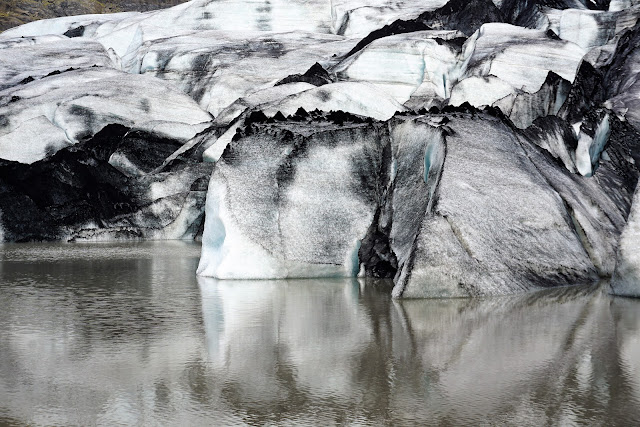June 13, 2019
One of the most unusual places we went in Iceland, at least from a photography standpoint, was the Sólheimajökull glacier, one of several "outlet" glaciers of the Myrdalsjökull icecap, which is itself Iceland's 4th biggest icecap. "Sólheimajökull" means "Home of the sun glacier." One of the things that makes Sólheimajökull popular with tourists is the fact that it is easily accessible from the road and less than 100 miles from Reykjavik.
It takes just fifteen or twenty minutes to walk from the parking lot along a dirt pathway to the glacier:
The Sólheimajökull Glacier is five miles wide and one mile deep. Some scientists think that if current melting rates continue, this glacier will be gone in a few decades. See it while you can.
The approach to the main glacier has a lagoon that must have been created by glacier melt. It doesn't look that big until you notice the tiny people at the bottom left of the photo:
Wait. Are those BLACK icebergs? Or are they chunks of lava or charred wood? They are shiny like obsidian, but rocks can't float--can they?
They appear to have slid into the water at the end of the long, gradual slope of the glacier, itself speckled and striped with black:
Brush away the black coating and you will find the dense glacial ice:
The Katla volcano last had a major eruption (one that broke through the ice cap) in 1918, when it erupted for 24 days. Yes, TWENTY-FOUR DAYS. The caldera is 6.2 miles wide and is covered with 660 to 2,300 feet of ice. When Katla blows again, it's going to be epic.
Here is Bob, loving the cool, clean air while I'm hoping that Katla keeps her cool:
There are several of these little pools spread about like a giant's footprints on the shore. I wonder how deep they are? The water in these holes is called "glacial milk." Its milky color comes from the particles that are ground into dust the consistency of flour underneath the glacier as it moves heavily across the earth. It is said to have fantastic health benefits if you drink it, which (unfortunately for us, perhaps) we did not.
Instead, we were mesmerized by this view, imposing spires of ice of the whitest white and blackest black adorned with streaks of saphhire blue:
It's possible to go on an expedition onto the ice, and we saw a group putting on crampons and readying other gear:
It would be a formidable challenge, that's for sure.
We decided to stay put. Seeing the glacier from the "safe" side was enough for us:



























It was fun hiking up to the base of the glacier. A nice change of pace from viewing waterfalls.
ReplyDelete